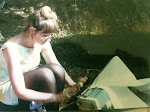While I was in NYC I came across a small publication called The First Line. Its a quarterly short fiction publication that provides the first line of a story and then asks writers (well, the general public) to fill in the rest. The result is a series of short pieces, which although start off in the exact same place, end up telling diverse and interesting stories. I thought I would give it a go. I've been getting in to short fiction and I have never submitted anything before. After a greuling afternoon sitting in a coffee shop in Hoboken banging out a story and making my friends and family read through the result, I actually submitted the work. It was hard, mostly because I knew I would never be accepted. I had to face up to the fact that I am absolutely NOT a genius. But it was an important step towards being a real writer. Two weeks later I received the "we regret to inform you" email. Bummer. But thats ok, cos now I can publish it here!
Three thousand habitable planets in the known universe and I’m stuck on the
only one without an ocean. In fact, with no water at all. Essentially a dead
planet- unable, incapable, of supporting life. The stillness is unbearable.
The whim of nature is lost. I had always equated the ocean with some kind
of romanticism. Standing at the end of the pier with nothing between me
and Antarctica. Here there is just nothing. In a way, this is romantic too.
We had been sent by the collective government to reclaim the planet for
future human colonisation. Technological advancements in atmospheric
stimulators had resulted in a rhizome of planet-city reclaim by the human
race. Abandoned alien cities, previously uninhabitable were now made
available due to the invention of the STAC (stimulated terrestrial atmospheric
circulator). The machine was more or less a gigantic humidifier, releasing
moisture into the air, which was in every other way perfect to support human
life.
Water content had long been our downfall. Humans are made of water. Our
very basic functions, even at a cellular level, require water. Its necessity
had turned it into a powerful weapon in warfare and a constant in the
geographical distribution of our species on earth and across the universe.
This city planet had long been abandoned, just like every other planet we
humans had discovered. It was as if the neighbourhood had turned bad and
the inhabitants had decided to get out before something horrible happened.
Every solar system was the same. Entire city planets without a single living
thing. Here, its occupants had mysteriously left terraces, temples and
monolithic structures. They had stood for centuries without a living breath.
Every surface on the city-planet was constructed with a dark sleek stone
known as Ark. It was crafted with the upmost detail meaning that each piece
of the Arkstone slid in to the next and required no joining agent. The result
was seamless, as if the buildings were cast from a mould. Rising hundreds
of metres into the air it was difficult to imagine that these buildings did not
contain a single nail, bolt or screw.
When we arrived here we took several weeks to perform a set of final tests on
the atmosphere. We needed data on the surface fluctuations so that we could
estimate the effectiveness of the STAC. We set up camp on a small uprising
in the Eastern district of the city. Here we were able to nestle amongst some
small dwelling-structures that overlooked an open area. We were daunted by
the thought of being the only life on the planet.
The first few weeks were hard. The surface of the planet and the pewter
darkness of the Arkstone were difficult to adjust to. Our eyes, used to the
bright and contrasting colours of our home, were strained by the dark pallet.
Subtleties, on a monochrome planet, were very important. We needed to
adjust to seeing in shades and shapes instead of colour. It felt as though we
had fallen into a city designed by modernist suprematists- Malevich’s White
on White became Ark on Ark. By the end of each day our eyes ached from
looking.
The oppressive darkness of the aesthetic was palpable. We longed for plants,
animals, trees. I longed for the sea. The constant movement of water. The salt
in the wet air. It was as though we were haunted by the ghosts of the builders
of the planet. “Get out, you don’t belong”. Their spectre was hidden in every
piece of crafted ark, the walls, the floor and every surface contained their
unknown history.
By the time the tests were completed we were slightly more at ease with our
surroundings. We tripped less often, our depth perception having corrected
itself a little more with every subsequent fall. We had spent some time
exploring the caverns of the terraces, taking it upon ourselves to begin crude
maps of the space. We noted the internal structure of the buildings and
the way in which the Arkstone maintained a constant temperature despite
fluctuations outside. We climbed thousands of smooth, worn stairs to find
suitable places to install the STAC’s.
In the late evenings I would sit on the plateau at the top of the terraces and
stare endlessly at the horizon on the south side. A chasm sat between me
and the temple district of the City-planet. Low lying structures of arsenic grey
formed a concave bowl. At the far side of this curve of stone sat the temple,
a stark pyramid against the violet sky. Like oxidised silver, the temples dark
matte surface gleaned with a hidden shine in the fading light. As my eyes
adjusted the subtleties of the buildings became more obvious. The structures
below seemed to lap at the base of the temple. If this planet didn’t have an
ocean, it had in its place an architecture of oceanic qualities. The mystery of
the sea was set in the shadowy depths of the Arkstone. I could almost taste
the salt.
At dawn on the 42nd morning the first STAC arrived. We estimated it would
take 28 machines evenly distributed across the planet to amply humidify the
air. Standing on the wide plateau one mile from our base camp we watched
as the STAC entered the planets atmosphere. It remotely navigated towards
the south end of the plateau as per co-ordinates we had entered into its
computer via communicators.
The STAC’s mechanical construct sat alien. Its steel frame and blazing
colours were a blemish. Its jutting edges and scar like rivets were at odds with
its surrounds. It pained our eyes to be exposed to the colours again, after
so long. Orange, yellow and black with enamel shine blazed in the morning
sun. We wondered if we were doing the right thing by this planet. Would
the previous owners approve of our brazenly egotistical colonization at the
expense of the planets aesthetic?
The Arkstone had seemed so depressing, monotonous and unyielding but
we realised it’s mystery was deeply engaged with its history. Each day we
discovered new districts and explored the dense, labyrinthine urban space.
We were beginning to build rapport with the city, communicating with its
builders through the culture of its architecture. The cool, sleek stone now
formed the walls of our home.
Around midday we were ready to turn the primary STAC on and
simultaneously the other 27. We felt the ground vibrate and as the STAC
came to life we heard for the first time the whirring of its motors. The Chasm
below echoed its low mechanical reverberation. The dry air carried the
sound through the passages of the city-planet, rippling waves of noise
rushed along the closed walkways and dispersed among the columns.
The vibrations were the first mechanical movement this city-planet had
felt since its ancient abandonment. As the rumble cascaded through the
maze of structures the sound waves slowly began to change. The narrow
passages affected the resonation of the sound, producing a higher pitch. On
the terraces the sound bounced back and forth, different vibrations interacting
with each other. The city-planet had begun to sing.
Amazed by the phenomena we sat, facing south and listened to the planet
emitting a chorus previously unheard. We marvelled at the beauty of the city-
planets architecture. Had the previous owners known about the sound-scape?
Perhaps it had been planned, a planet designed to transmit sound, to turn life
into music.
A few hours passed and a steady stream of moisture was emitted from the
STAC. The effect was mesmerising, a mirage like stream of water rich air
glittered in he sky. It was as if a cloud of liquid mercury had been released.
The particles of water vapour each individually reflected the pewter grey of the
planet and simultaneously refracted the sunshine.
As the humidity began to settle in the lower atmosphere we noticed that the
vibrations had stopped spreading. The waves of sound were now slowed by
the particles of water in the air. Now all that remained was a mechanical hum
that made us realise how we had become used to the silence of the empty
planet. As the Arkstone itself began absorbing the moisture, it began to glean
with an unexpected shine.
Sitting on the plateau and looking south we wondered how long this beauty
would remain. The city-planet was now ready for colonisation and would be
filled with displaced families, nomads, entrepreneurs and people looking
for escapes and new starts. The streets and buildings would be named. A
burgeoning future. The loneliness and the beauty that the city-planet offered
was transient. And soon the romance would be lost.



No comments:
Post a Comment